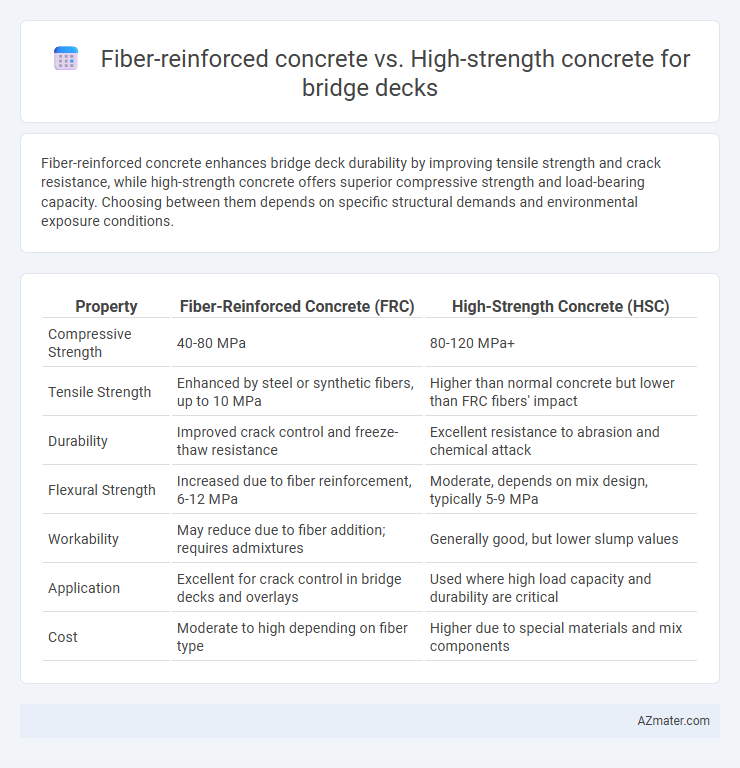Fiber-reinforced concrete enhances bridge deck durability by improving tensile strength and crack resistance, while high-strength concrete offers superior compressive strength and load-bearing capacity. Choosing between them depends on specific structural demands and environmental exposure conditions.
Table of Comparison
| Property | Fiber-Reinforced Concrete (FRC) | High-Strength Concrete (HSC) |
|---|---|---|
| Compressive Strength | 40-80 MPa | 80-120 MPa+ |
| Tensile Strength | Enhanced by steel or synthetic fibers, up to 10 MPa | Higher than normal concrete but lower than FRC fibers' impact |
| Durability | Improved crack control and freeze-thaw resistance | Excellent resistance to abrasion and chemical attack |
| Flexural Strength | Increased due to fiber reinforcement, 6-12 MPa | Moderate, depends on mix design, typically 5-9 MPa |
| Workability | May reduce due to fiber addition; requires admixtures | Generally good, but lower slump values |
| Application | Excellent for crack control in bridge decks and overlays | Used where high load capacity and durability are critical |
| Cost | Moderate to high depending on fiber type | Higher due to special materials and mix components |
Introduction to Bridge Deck Materials
Fiber-reinforced concrete (FRC) enhances durability and crack resistance by incorporating synthetic or steel fibers into the mix, making it ideal for bridge decks subjected to heavy traffic loads and environmental stress. High-strength concrete (HSC) offers exceptional compressive strength beyond 6000 psi, enabling reduced cross-sectional thickness and longer span capabilities, but may be more susceptible to brittleness without reinforcement. Selecting between FRC and HSC depends on balancing load-bearing requirements, durability, maintenance considerations, and cost-effectiveness in bridge deck construction.
Overview of Fiber-Reinforced Concrete
Fiber-reinforced concrete (FRC) incorporates discrete fibers such as steel, glass, or synthetic materials to enhance tensile strength, toughness, and crack resistance, making it highly suitable for bridge decks exposed to dynamic loads and environmental stresses. FRC improves durability and reduces maintenance needs by mitigating shrinkage cracks and impact damage, which are critical factors for bridge deck longevity. In comparison to high-strength concrete, FRC offers better post-cracking behavior and energy absorption, contributing to safer and more resilient bridge structures.
Overview of High-Strength Concrete
High-strength concrete (HSC) for bridge decks typically exhibits compressive strengths exceeding 6000 psi (41 MPa), offering enhanced load-bearing capacity and durability compared to conventional concrete. Its dense microstructure reduces permeability, improving resistance to environmental factors such as freeze-thaw cycles and chloride-induced corrosion. HSC's improved mechanical properties contribute to longer service life and reduced maintenance costs in bridge deck applications.
Key Mechanical Properties Comparison
Fiber-reinforced concrete exhibits enhanced tensile strength, improved crack resistance, and superior impact energy absorption compared to high-strength concrete, making it more durable against dynamic loads on bridge decks. High-strength concrete offers greater compressive strength and stiffness, which supports higher load-carrying capacity but is more brittle under tensile stresses. The combination of fiber reinforcement with high-strength matrices optimizes toughness and ductility, enhancing overall mechanical performance in bridge deck applications.
Durability and Longevity Factors
Fiber-reinforced concrete enhances bridge deck durability by improving crack resistance, impact toughness, and fatigue performance, which reduces maintenance frequency and extends service life. High-strength concrete offers superior compressive strength and reduced permeability, minimizing chloride ion penetration and thus corrosion risks to reinforcement. Combining fiber reinforcement with high-strength concrete optimizes bridge deck longevity by synergistically addressing mechanical stress and environmental degradation factors.
Crack Resistance and Flexural Performance
Fiber-reinforced concrete (FRC) significantly enhances crack resistance and flexural performance in bridge decks by distributing tensile stresses through embedded fibers, reducing crack width and propagation. High-strength concrete (HSC) provides superior compressive strength but may exhibit brittleness, leading to higher susceptibility to sudden crack formation under flexural loads. Combining fiber reinforcement with high-strength matrix improves durability and load-bearing capacity, optimizing bridge deck performance under dynamic and environmental stresses.
Construction and Workability Differences
Fiber-reinforced concrete (FRC) enhances tensile strength and crack resistance in bridge deck construction by incorporating fibers that improve post-cracking behavior and durability without significantly altering workability. High-strength concrete (HSC) offers superior compressive strength, requiring precise mix designs and often reduced water-cement ratios, which can lead to decreased workability and increased need for admixtures or superplasticizers during placement. Construction with FRC typically allows for easier placement and finishing due to maintained workability, whereas HSC demands more careful handling and curing practices to prevent early-age cracking and ensure optimal performance in bridge decks.
Cost Analysis and Economic Impact
Fiber-reinforced concrete (FRC) reduces maintenance costs for bridge decks through enhanced crack resistance and durability, leading to lower life-cycle expenses compared to traditional high-strength concrete (HSC). Although the initial material cost of FRC may be higher due to fiber additives, its extended service life and reduced repair frequency provide significant economic benefits over time. In contrast, HSC offers higher compressive strength at a lower upfront cost but often requires more frequent maintenance, increasing long-term expenditures.
Suitability for Various Bridge Deck Applications
Fiber-reinforced concrete enhances crack resistance and durability, making it ideal for bridge decks exposed to heavy traffic and dynamic loads. High-strength concrete offers superior compressive strength, suited for bridge decks requiring minimal thickness and high load-bearing capacity. Selection depends on traffic intensity, environmental conditions, and design specifications, with fiber-reinforced concrete favored for impact resistance and high-strength concrete for structural efficiency.
Conclusion: Choosing the Right Concrete for Bridge Decks
Fiber-reinforced concrete enhances durability and crack resistance, making it ideal for bridge decks exposed to heavy traffic and dynamic loads. High-strength concrete offers superior compressive strength and longevity, suitable for structures demanding increased load capacity and minimal maintenance. Selecting the right concrete depends on project-specific requirements like load conditions, environmental exposure, and budget constraints to ensure optimal bridge deck performance and lifespan.

Infographic: Fiber-reinforced concrete vs High-strength concrete for Bridge deck
 azmater.com
azmater.com